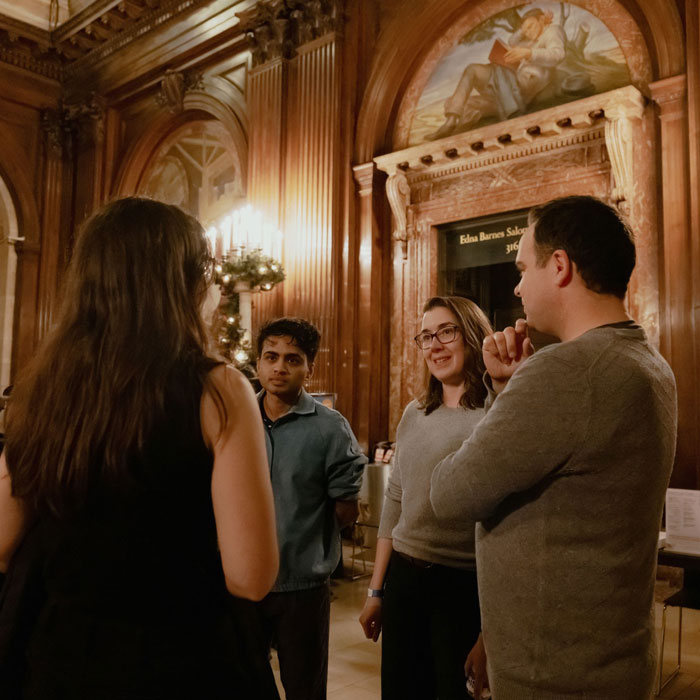So, are you a “math person,” or are you more of a creative type?
It’s a ridiculous question — you certainly can be both creative and skilled at math — but it’s one you’ve probably heard before. We’ve grown up in a society that largely dichotomizes these two characteristics.
Natalie Gosnell, a professor of physics at Colorado College, wants to change the way we see and practice physics. For her, physics comes most naturally as a creative process and for the duration of her career learning and practicing physics, she’s struggled with external pressures to separate her creative and scientific selves.
“Both artists and scientists are just observing things about the world, making interpretations about those observations, and then sharing their interpretation,” says Gosnell.
Despite the strong ties she feels between art and science, she’s had to work for years in a society divided. Gosnell sees this division rooted in the systemic racism and sexism that the physics institution has been born into, which limits what physics could be and limits the people who feel welcome practicing it.
“As an astrophysicist, I'm a product of institutions that are steeped in systemic racism and white supremacy,” Gosnell says. “The tenets of white supremacy that show up [in physics] of individualism and exceptionalism and perfectionism… it’s either-or thinking, and there's no subtlety, there's no gray area. All of this manifests in the way that we think about our research, and what counts as good research, what counts as important research?”
Most of Gosnell’s career has been dictated by the hyper-masculine world of astrophysics. Now, she is deciding that she doesn’t have to fit into that mold — she is changing the ways she teaches physics, and the way she professionally shares it.
Gosnell’s new immersive art piece entitled “The Gift” walks the line in between creativity and science, and exemplifies that which was missing for Gosnell in the sharing of science: creativity. The piece is experienced in a room with audial and visual stimuli, and through a book about an astrophysical phenomenon of a dying star as seen through the eyes of Gosnell and her co-creators, Janani Balasubramanian and Andrew Kircher.
The story goes as follows: Two stars are orbiting one another, and just before one is about to die it swells up to hundreds of times its previous size — in doing this, it transfers its mass to its orbiting star. Then the swollen star dies, while the other one shines brighter and bluer than it did before thanks to its companion.
Contemporary journalism views this mass-transfer process through a violent, hyper-masculine lens, seeing as the mass-receiving star has been dubbed “Vampire star” or “Cannibal star.” Gosnell adds they are viewed as the “bad boys” of the universe.
“I think because science and art have been so separated, and there's [...] systemic issues within science, the metaphors that are often chosen [to discuss science] are very violent and hyper-masculine,” she says.
Gosnell was featured in 2010 on “How the Universe Works,” a show on the Discovery channel, to talk about her research on the mass-transfer phenomenon.
“And I totally played into [the hyper-masculine stereotypes], because, ooh, snazzy. I get to be on the Discovery Channel,” Gosnell says of the experience. “Of course, like, the price was too high.”
“It felt like I was masquerading, essentially, as what an astrophysicist was supposed to be like,” Gosnell says. To be clear, having been published many times and received the Cottrell Scholar Award (highly sought after in her area), Gosnell was and is well established as an astrophysicist.
The exclusive environment of physics is well-documented: research published at the American Institute of Physics, the American Physical Society, and other reputable physics publications has spotted a trend that most of us could already guess — white men, across the board, tend to have the strongest sense of belonging in physics. Persons of color and women’s involvement and success in physics is markedly low.
“The Gift” is one piece of Gosnell’s greater plan to change the physics environment into a more accessible one. She also has created a new curriculum in which creativity is directly embedded into classes, which is not the norm in the physics classroom. In true astrophysicist fashion, she is conducting research on her teaching method by following students’ progress in physics identity and belongingness after they’ve taken her class. She’s conducted it three times thus far and has already seen that people (everyone — not just white males) have a stronger sense of physics identity following her classes.
Gosnell is now teaching classes in a way that she would have benefitted from when she was learning physics — instead of molding her students into the stereotypes that felt so rigid and limiting in Gosnell’s career, she is incorporating creativity directly into the learning.
“We can make different choices about the metaphors that we use, in the stories that we tell, which is where [...] the inspiration and goal behind ‘The Gift’ comes from.”
Gosnell, Kircher, and Balasubramanian’s accessible performance installation “The Gift” opened at the New York Public Library on Dec. 6 and will come to the CC Fine Arts Center Block 7 of 2023. See the piece installed and experience “The Gift” — a story of one dying star and a companion who shines brighter for the loss — this spring.
“The Gift” was created with the generous support of Lincoln Center for the Performing Arts, The Public Theater, New York Community Trust, the Sundance Institute, the Guild of Future Architects, MAP Fund, Stanford University, Brooklyn College, Creativity & Innovation at Colorado College, The University of Colorado, and The Tow Foundation. It was developed in part in the Collider, a research and development lab for the performing arts at Lincoln Center. The Collider is generously supported by founding partner Diana Chen. Major support for the Collider is provided by The Ford Foundation and The Mellon Foundation.



